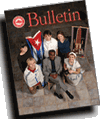
Where is this cross-cultural journey taking us?In 1967, English professor J. Daniel Hess greeted the very first group of Study-Service Term students as they arrived in Costa Rica. At that point, he said, "we were too naïve to be petrified. Costa Rica looked, sounded, smelled, tasted and behaved itself differently from Hoosierland. But our host families, the language school, the bi-national center and an office of college scholarships for Costa Ricans surrounded us with goodwill and lots of help. Just wonderful."Hess watched students' efforts to communicate in another language and navigate daily life in another culture. Early challenges for him included "buying corvina (white fish) at a good price, negotiating for a house in Spanish with a Realtor and learning how to manage myself during an aquacero (heavy rain) on days I forgot my umbrella." With these daily adventures, Hess also understood that the program was an innovation, yielding benefits seldom articulated, in the late 1960s, as important among higher educational institutions. "We soon recognized how quickly students moved from indifference to learning," he said. "And we were surprised to discover that cross-cultural challenges, in all their utter complexities, became a workplace for character development." Navigating cross-cultural challenges. Acknowledging complexities. Character development. While many colleges and universities tout these values in their 21st century study-abroad and service-learning programs, SST is different because of its inspiration. Because if we strip SST to its core - knowing that the program arose from recognizing and building on outstanding international experiences of faculty, often rooted in church service, and was molded into an academically sound, ground-breaking service-learning semester - we see a very different source than most study-abroad programs: Goshen College is Christ-centered. As such, we are asked to appreciate the diversity of the world and become better stewards of its precious inhabitants and environments. We are called to respect and love others and to overcome barriers that we humans create - stereotypes, racism, cultural and social stratification and political and even religious systems that place us at odds. We are challenged to not just idly watch the panorama of life, but to engage in it fully toward creating a more just and peaceful world. Kingdom building - no small order, but SST is one creative way of opening our eyes to the possibilities for an active faith linked with learning. However lofty these goals may sound for one program, it is the smaller, individual stories of SSTers that adds up to the transformational experience. In this issue of the Bulletin, we uncover some of those stories as shared with students and faculty who opened units in Cuba and Ethiopia during the summer of 2002. We hope you enjoy the textures and colors of these two new SST host countries as shared through the stories of those who stepped on unfamiliar soil to meet and become new people. |


